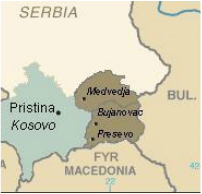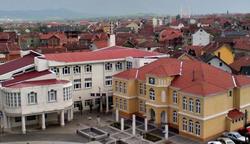Albanians in Serbia
Albanians in Serbia (Albanian: Shqiptarët në Serbi; Serbian Cyrillic: Албанци у Србији) are an officially recognized ethnic minority in Serbia. An estimate of 50,000–80,000[1][2][3][4] Albanians live in Serbia out of whom majority live in the municipalities of Preshevo (Albanian: Preshevë), Bujanovac (Albanian: Bujanoc), and part of the municipality of Medveđa (Albanian: Medvegjë). According to the results of the 2002 census, there are 61,467 Albanians who live in Serbia. Most Albanians boycotted the 2011 census, which resulted in only 5,809 Albanians being recorded as living in Serbia.[5]
Geography

In the municipalities of Preševo and Bujanovac Albanians form the majority of population (89.1% in Preševo and 54.69% in Bujanovac according to the 2002 census). In the municipality of Medveđa, Albanians are second largest ethnic group (after Serbs), and their participation in this municipality was 28.67% in 1991 and 26.17% in 2002.[6] The region of Bujanovac and Preševo is widely known as the Preshevo Valley (Serbian: Прешевска Долина, Preševska Dolina, Albanian: Lugina e Preshevës).
There is a small community of Albanians in the Pešter region of Sandžak living in villages such as Boroštica, Doliće and Ugao.[7] For the past two generations these villages have become partly bosniakicised, due to intermarriage with the surrounding Bosniak population.[7] As such and also due to the Yugoslav wars and thereafter, they have opted to declare themselves in censuses as "Muslims" and "Bosniaks" instead of as Albanians to avoid problems.[7] Elders in these villages are still fluent in Albanian.[7]
There is a small community of Albanians in the Pešter region of Sandžak living in villages such as Boroštica, Doliće and Ugao.[7] For the past two generations these villages have become partly bosniakicised, due to intermarriage with the surrounding Bosniak population.[7] As such and also due to the Yugoslav wars and thereafter, they have opted to declare themselves in censuses as "Muslims" and "Bosniaks" instead of as Albanians to avoid problems.[7] Elders in these villages are still fluent in Albanian.[7]
History

In 1992, the Albanian representatives in the municipalities Preševo, Medveđa and Bujanovac organized a referendum in which they voted for the joining of these municipalities to the self-declared assembly of the Republic of Kosova.[8] Between 1999 and 2001, an ethnic Albanian guerilla organization, the Liberation Army of Preševo, Medveđa and Bujanovac (in Albanian Ushtria Çlirimtare e Preshevës, Medvegjës dhe Bujanocit, UÇPMB), was operational in this region with a goal to secede these three municipalities from the FR Yugoslavia and join them to Kosovo upon achieving independence. The activities attracted less international media interest than the related events of Kosovo and Macedonia.
Since then, the Albanian Coalition from Preševo Valley has gained representation in the National Assembly of Serbia where it holds two seats.
Since then, the Albanian Coalition from Preševo Valley has gained representation in the National Assembly of Serbia where it holds two seats.
Culture
Education in Albanian is provided for primary and secondary schools. There may be some university-level courses provided in Albanian, in the capital of Serbia, Belgrade, but students mainly do their university degree in the University of Prishtina in the Republic of Kosovo, in Macedonia, or in Albanian Universities.
The main religion of Albanians in this region is Islam. Prior to the Ottoman invasion of the Balkans, the population of the Preševo Valley was mostly Roman Catholic. There are still Catholic churches in the Karadak villages, located in Kosovo today.
The main religion of Albanians in this region is Islam. Prior to the Ottoman invasion of the Balkans, the population of the Preševo Valley was mostly Roman Catholic. There are still Catholic churches in the Karadak villages, located in Kosovo today.
Albanians in Belgrade
Belgrade has a minor Albanian community. In the census of 1981, 8,212 Albanians were registered. In 1991 there lived only 4,985 Albanians in Belgrade. After the Kosovo War, this number decreased to 1,492, and according to the latest census (2011), the number is 1,252.
Year 1948 1953 1961 1971 1981 1991 2002 2011
Albanians 1373, 2628, 2626, 9788, 2124, 9851, 4921, 1252
Year 1948 1953 1961 1971 1981 1991 2002 2011
Albanians 1373, 2628, 2626, 9788, 2124, 9851, 4921, 1252
Notable people
- Fidan Aliti, football player
- Faruk Begolli,
- Nexhat Daci
- Bekim Fehmiu,
- Riza Halimi, politician and former Mayor of Preševo municipality
- Floriana Ismaili, football player
- Jonuz Musliu, head of the UCPMB political wing.
- Zana Nimani,
- Donika Nuhiu, well-known pop singer.
- Berat Xhimshiti, football player
Also see
References
- "South Serbia Albanians Seek Community of Municipalities". Retrieved 17 July 2013. South Serbia is home to 50,000 or so Albanians.
- Partos, Gabriel (2 February 2001). "Presevo valley tension". BBC. Retrieved 14 January 2015. Initially, the guerrillas' publicly acknowledged objective was to protect the local ethnic Albanian population of some 70,000 people from the repressive actions of the Serb security forces.
- "The Presevo Valley of Southern Serbia alongside Kosovo The Case for Decentralisation and Minority Protection" (PDF). Retrieved 24 October 2013. The total population of the Valley is around 86,000 inhabitants of whom around 57,000 are Albanians and the rest are Serbs and Roma
- "Yugoslavia: Serbia Offers Peace Plan For Presevo Valley". Retrieved 24 October 2013. The Serbian peace proposal calls for integrating the Presevo valley's 70,000 ethnic Albanian residents into mainstream Serbian political and social life.
- "2011 Census of Population, Households and Dwellings in the Republic of Serbia: Ethnicity" (PDF). Belgrade: Statistical Office of the Republic of Serbia. 2012. Retrieved 17 February 2015.
- Popis stanovništva, domaćinstava i Stanova 2002. Knjiga 1: Nacionalna ili etnička pripadnost po naseljima (in Serbian). Statistical Office of the Republic of Serbia. 2003. ISBN 86-84433-00-9.
- Andrea Pieroni, Maria Elena Giusti, & Cassandra L. Quave (2011). "Cross-cultural ethnobiology in the Western Balkans: medical ethnobotany and ethnozoology among Albanians and Serbs in the Pešter Plateau, Sandžak, South-Western Serbia." Human Ecology. 39.(3): 335. "The current population of the Albanian villages is partly “bosniakicised”, since in the last two generations a number of Albanian males began to intermarry with (Muslim) Bosniak women of Pešter. This is one of the reasons why locals in Ugao were declared to be “Bosniaks” in the last census of 2002, or, in Boroštica, to be simply “Muslims”, and in both cases abandoning the previous ethnic label of “Albanians”, which these villages used in the census conducted during “Yugoslavian” times. A number of our informants confirmed that the self-attribution “Albanian” was purposely abandoned in order to avoid problems following the Yugoslav Wars and associated violent incursions of Serbian para-military forces in the area. The oldest generation of the villagers however are still fluent in a dialect of Ghegh Albanian, which appears to have been neglected by European linguists thus far. Additionally, the presence of an Albanian minority in this area has never been brought to the attention of international stakeholders by either the former Yugoslav or the current Serbian authorities."
- organized a referendum in which they voted that Preševo, Medveđa and Bujanovac should join Kosovo
